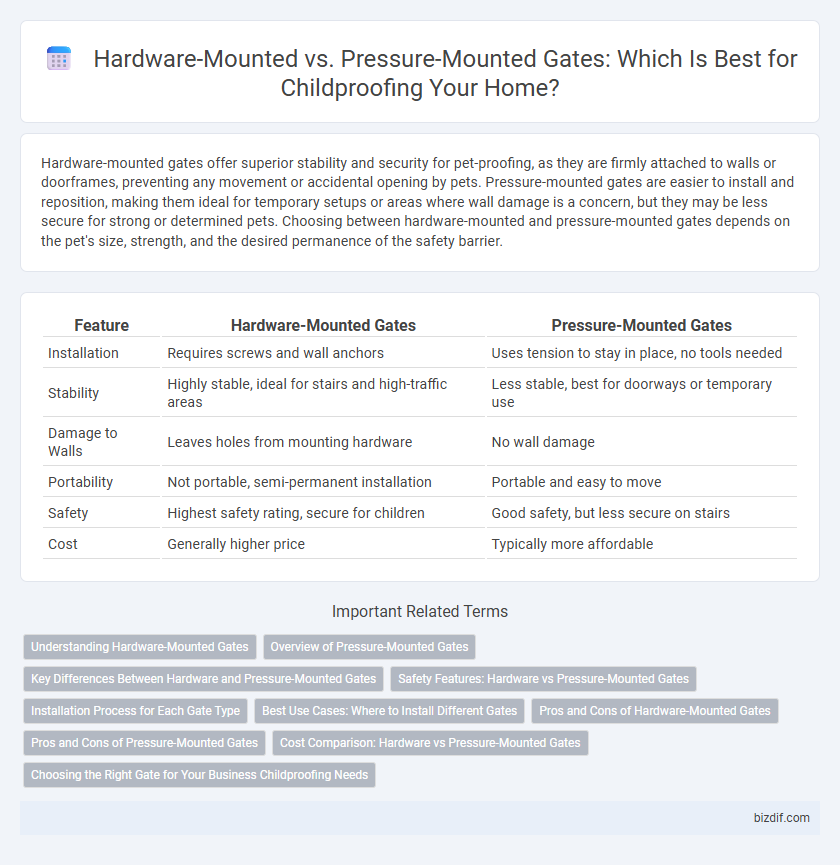Hardware-mounted gates offer superior stability and security for pet-proofing, as they are firmly attached to walls or doorframes, preventing any movement or accidental opening by pets. Pressure-mounted gates are easier to install and reposition, making them ideal for temporary setups or areas where wall damage is a concern, but they may be less secure for strong or determined pets. Choosing between hardware-mounted and pressure-mounted gates depends on the pet's size, strength, and the desired permanence of the safety barrier.
Table of Comparison
| Feature | Hardware-Mounted Gates | Pressure-Mounted Gates |
|---|---|---|
| Installation | Requires screws and wall anchors | Uses tension to stay in place, no tools needed |
| Stability | Highly stable, ideal for stairs and high-traffic areas | Less stable, best for doorways or temporary use |
| Damage to Walls | Leaves holes from mounting hardware | No wall damage |
| Portability | Not portable, semi-permanent installation | Portable and easy to move |
| Safety | Highest safety rating, secure for children | Good safety, but less secure on stairs |
| Cost | Generally higher price | Typically more affordable |
Understanding Hardware-Mounted Gates
Hardware-mounted gates provide a secure barrier by attaching directly to walls or door frames with screws, making them ideal for stairways and high-traffic areas where safety is critical. Unlike pressure-mounted gates, hardware-mounted gates are more stable and cannot be easily dislodged by children, ensuring long-lasting protection. Their installation requires tools and minor wall modification, but this trade-off offers superior durability and reliability in childproofing homes.
Overview of Pressure-Mounted Gates
Pressure-mounted gates offer a convenient and versatile childproofing solution by using tension to secure the gate between two surfaces without hardware installation. Ideal for temporary setups and easy relocation, these gates effectively block off areas such as staircases or kitchens where children should not enter. Their lightweight design and simple installation make them a popular choice for rental homes and quick safety adjustments.
Key Differences Between Hardware and Pressure-Mounted Gates
Hardware-mounted gates attach securely to walls or doorframes using screws, providing maximum stability and safety ideal for stairways or high-traffic areas. Pressure-mounted gates use tension to hold in place between two surfaces, offering easy installation without drilling but are less stable under significant force. Choosing between hardware-mounted and pressure-mounted gates depends on the required strength, location, and ease of installation.
Safety Features: Hardware vs Pressure-Mounted Gates
Hardware-mounted gates offer superior safety features by securely attaching to walls or door frames, preventing accidental dislodgement and ensuring stability in high-traffic areas. Pressure-mounted gates rely on adjustable tension to stay in place, which may be less secure on uneven surfaces or against strong pushes, posing potential safety risks for active children. The choice between these gates should consider the specific environment and the level of security required to effectively prevent access to hazardous areas.
Installation Process for Each Gate Type
Hardware-mounted gates require professional installation with screws drilled directly into walls or banisters, ensuring a secure and permanent barrier ideal for staircases and high-traffic areas. Pressure-mounted gates rely on adjustable tension rods that wedge between walls without drilling, making them easier to install and relocate but less stable for top-of-stair use. Choosing between the two depends on the installation surface and the level of security needed in childproofing your home.
Best Use Cases: Where to Install Different Gates
Hardware-mounted gates provide secure, permanent barriers ideal for staircases and high-traffic areas, ensuring maximum safety in homes with active toddlers. Pressure-mounted gates offer a versatile, damage-free solution perfect for doorways, hallways, or temporary barriers where frequent removal is necessary. Selecting the appropriate gate depends on location stability needs and ease of installation requirements for effective childproofing.
Pros and Cons of Hardware-Mounted Gates
Hardware-mounted gates provide superior security by being firmly attached to walls or door frames, making them ideal for staircases and high-traffic areas. They offer enhanced durability and are less likely to be dislodged by active toddlers, ensuring maximum safety. However, installation requires drilling, which can potentially damage walls and may not be suitable for renters or those who prefer a non-permanent solution.
Pros and Cons of Pressure-Mounted Gates
Pressure-mounted gates are easy to install and move, making them ideal for temporary use and multiple rooms without damaging walls or door frames. They may lack the sturdiness of hardware-mounted gates, which can pose safety risks if placed at the top of stairs or in high-traffic areas. The convenience of pressure-mounted gates is balanced by lower stability compared to hardware-mounted options, requiring careful placement to ensure childproofing effectiveness.
Cost Comparison: Hardware vs Pressure-Mounted Gates
Hardware-mounted gates typically cost between $50 and $150 due to their sturdy construction and permanent installation design, making them a long-term investment for childproofing. Pressure-mounted gates generally range from $30 to $80 and offer a more affordable, temporary solution without drilling or hardware installation. While pressure-mounted gates provide cost savings upfront, hardware-mounted gates deliver enhanced durability and security, potentially reducing replacement or maintenance expenses over time.
Choosing the Right Gate for Your Business Childproofing Needs
Hardware-mounted gates provide superior stability and security by being firmly attached to walls or door frames, making them ideal for high-traffic commercial spaces requiring reliable childproofing solutions. Pressure-mounted gates offer easy installation and portability, suitable for temporary setups or areas where drilling is not permitted, but may be less secure under heavy use. Selecting the right gate depends on the business's specific safety requirements, foot traffic, and installation preferences to ensure optimal child safety and compliance with local regulations.
Hardware-Mounted Gates vs Pressure-Mounted Gates Infographic

 bizdif.com
bizdif.com